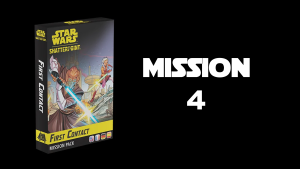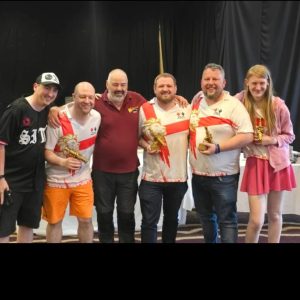As some of you may know we are coming up on our 1-year anniversary of the Iron & Tentacles RPG podcast! With that milestone, I have been thinking a lot about how I can be a great Dungeon Master and what that really means to my players. I have talked on the cast a few times about it, and have had conversations with my players about what makes a great DM. The one thing I keep coming back to is… storytelling.
Your Goal as a Dungeon Master

As a Dungeon Master, our primary role is to guide the story and, just as importantly, set the rules of the world our players are exploring. We are not only a storyteller but also a gatekeeper of what is and isn’t possible within the game’s universe. One example I like using here is that players need to understand fundamental truths about their world for instance gravity is a fundamental truth of the real world and it dictates everything we can expect about the world’s reaction to an action. Establishing these boundaries ensures the narrative stays cohesive while still giving players the freedom to explore creatively. In this article, I am going to focus on how to adapt to your players’ style while maintaining your role as a worldbuilder, helping you craft memorable, collaborative experiences.
When starting a new campaign or session, it can be helpful to begin with some clear guardrails and a structured path for the players to follow. These initial boundaries serve as the “rules of the world,” outlining what characters can and can’t do, as well as establishing the tone and direction of the story. I think it’s important to communicate these limitations early, so players understand the logic of the world they’re inhabiting. This ensures everyone is on the same page about what actions are possible, what consequences might follow, and how far they can push the boundaries of the narrative (and the DM).
As you get to know your players and how they interact with the story, you can gradually move those guardrails. Subsequent sessions might involve more of an open-ended approach, where you have a general outline of key plot points or objectives but allow the players more agency in how they navigate between them. While your role remains to enforce the world’s logic and rules, you can also encourage creative problem-solving and unconventional thinking, if it fits within the framework you’ve established.
One of the Dungeon Master’s greatest responsibilities is balancing structure with flexibility. You set the rules of the world, but you also need to be adaptable to how the players engage with those rules. Whether your players are focused on character development, tactical challenges, or unpredictable antics (looking at you Keegan), your ability to adapt while maintaining the core logic of the world will ensure that the story remains engaging and immersive for everyone involved.
Understanding Player Styles
Every party is a unique blend of personalities, and each player brings their own style to the table. Some might be heavy role-players, diving deep into their characters’ motivations, while others might be more focused on strategy or moving the narrative forward. Recognizing these differences is key to crafting sessions that engage everyone.

- Role-players: These players thrive on character interaction and story depth. Give them opportunities to explore their characters’ emotions, relationships, and backstories.
- Power gamers: They love optimizing and crunching numbers. Challenge them with tactical encounters that reward smart thinking.
- Explorers: These players are curious about the world you’ve built. Provide them with rich lore, hidden secrets, and opportunities to uncover new parts of your setting.
- Socializers: Some players are there for the camaraderie. Keep the table lively and ensure there’s plenty of interaction, both in and out of character.
- Story lovers: This is the player that yearns for the next beat in the story. They will try to push the story forward when others are messing around. Let them, to a degree, be the leader allowing them some control of the progress.
- Loose Cannons: These players love to break the mold (and DMs) so this needs to be a section all on its own…
Loose Cannons: Embracing Unpredictability

Every party has that one player—the Loose Cannon. They’re the ones who love to throw a wrench into carefully laid plans, opting for the wild and unpredictable move instead of the straightforward approach. They cut a hole in a wall when there’s a perfectly usable door, or they decide to take a detour into a dangerous, unexplored area while everyone else is focused on the mission at hand. They thrive on chaos, and while it can challenge your game’s structure, these players often push the story in unexpected, exciting directions.
Rather than seeing these players as disruptive, there are ways to harness their energy and turn their unpredictability into opportunities for storytelling.
Embrace Their Creativity
First, don’t immediately shut down their wild ideas. Loose cannons are often driven by curiosity or a desire to push the boundaries of the world you’ve built. Rather than dismissing their unconventional actions, try to incorporate them into the narrative. Did they decide to try creating a relationship with a random NPC? Make that a story beat and add depth to it… maybe that NPC becomes a bigger part of the story later.
Their actions can lead to surprising, often fun situations that neither you nor the players saw coming. Sometimes, these moments become the most memorable parts of the campaign.
Set Boundaries When Needed
While creativity should be encouraged, it’s equally important to maintain some structure. If a loose cannon’s actions consistently derail the session or start to affect the enjoyment of other players, it’s time to gently rein things in.
You can set clear boundaries without squashing their creativity. Remind them that while the world is open for exploration, actions still have consequences. This could be as simple as a warning from an NPC or environmental factors that gently guide them back on track. By setting boundaries, you ensure that the story moves forward and is enjoyable for everyone at the table.
Turn Their Chaos into Opportunity
Loose cannons thrive on spontaneity, but their unpredictable decisions don’t have to derail the game. Instead, use their chaos as a narrative tool. For example, if they decide to cut through a wall instead of using the door, it reveals a hidden room, an unexpected challenge, or a secret passage that leads to the next part of the story. This allows their actions to feel significant while still moving the plot forward in a way that fits the world.
By weaving their unpredictability into the story, you make them feel like their decisions matter while keeping the game interesting for everyone else. Below is a reference table I put together with some ideas on how you can handle these situations.
Loose Cannon Scenarios Reference Table
| Action Taken by the Loose Cannon | Unexpected Consequence | Narrative Opportunity/Challenge Created |
| Forces entry through a wall or other non-conventional method | The wall collapses, revealing a hidden room or tunnel | Inside the room, there’s either a powerful artifact or a deadly trap, leading to a new challenge for the party. |
| Starts a fight with an NPC rather than negotiating | The fight attracts unwanted attention, like guards or local criminals | The party is forced into a tense escape or must navigate local factions to resolve the mess. |
| Uses a powerful spell or item in an unusual way | The spell/item backfires, causing an unintended effect, like a temporary curse | The party must now deal with the effects of the spell/item, which could impact them for the rest of the session. |
| Refuses to follow the party’s agreed-upon plan | The detour leads to a different encounter, such as a powerful enemy or hidden treasure | The party is thrown off course but might discover something valuable—or dangerous—that adds complexity to the story. |
| Ignites or breaks a piece of vital equipment | The destruction causes a system failure (e.g., shutting down lights or air supply) | The party must now navigate in the dark, repair the equipment, or deal with new hazards. |
| Engages with a suspicious or hostile NPC | The NPC is secretly part of a larger plot and either betrays or manipulates the party | The party is drawn into a political intrigue or larger conflict, adding layers to the story. |
| Ignores environmental hazards (e.g., walking into fire) | Takes immediate damage or causes an environmental reaction, like an explosion | The party is now in a race against time to escape a spreading hazard, like fire or poison. |
| Takes a cursed or dangerous object | The curse activates, either affecting the loose cannon or the entire party | The party must find a way to lift the curse or deal with its effects throughout the session. |
| Fails to heed warnings about a dangerous area | The area is revealed to be trapped or guarded by a formidable creature | The party now must either fight their way through or find a clever way to avoid confrontation. |
| Initiates a risky experiment with magic or technology | The experiment goes wrong, causing a rupture (e.g., time warp, void rift) | The party must solve a new puzzle or deal with a bizarre reality-bending encounter. |
| Attempts to recruit or tame a wild creature | The creature turns hostile, attacking the party | The party must now subdue the creature or escape and may later find it as a recurring adversary. |
| Uses a key item or resource recklessly | The item is lost or damaged beyond repair | The party must now seek out a replacement or find an alternative solution to the task ahead. |
| Disregards diplomatic attempts and insults a key NPC | The NPC’s faction is now hostile toward the party, complicating future encounters | The party now faces increased difficulty in future negotiations or must win back favor. |
| Decides to split from the party and go solo | Encounters a deadly trap or enemy alone | The party must now mount a rescue mission or deal with the fallout of the solo player’s actions. |
| Triggers a magical or mechanical trap without caution | The trap activates, releasing something unexpected like a poison cloud or summoned creatures | The party must navigate the consequences and deal with an ongoing threat that wasn’t part of the original plan. |
| Experiments with unfamiliar or forbidden magic/technology | Unleashes a powerful, unintended force | The party is now in a situation where they must either contain or flee from this new threat. |
| Disregards obvious clues or hints | The situation becomes more difficult, like losing an important ally or opportunity | The party now must work harder or deal with a setback they could have avoided. |
| Insists on pursuing personal goals rather than party objectives | Causes internal conflict or tension within the party | The party must resolve this tension, leading to a role-playing opportunity to mend relationships. |
| Bypasses a key plot point (e.g., skips an important encounter) | Missing critical information, the party is now at a disadvantage | The story becomes more challenging as they move forward without vital knowledge or resources. |
Creating a Collaborative Atmosphere

One of the most powerful tools in a DM’s toolkit is fostering an environment where players feel comfortable contributing to the narrative. This isn’t about relinquishing control but rather sharing the creative process.
- Encourage Player Input: Invite players to help shape the world. This could be through collaborative world-building, where players add to the setting’s history or culture, or through decisions that have lasting impacts on the story.
- Use Player Backstories: Insert player backstories into the main narrative. This not only gives characters personal stakes but also makes players feel like their contributions are meaningful.
- Ask Open-Ended Questions: Instead of dictating every outcome, ask your players how they’d like to resolve certain situations. For example, “What are you looking to do (or what outcome are you looking for)?” or “What does your character hope to achieve here?”
Balancing Your Story with Player Input
A good DM knows how to strike a balance between guiding the story and letting players take the reins. Your job isn’t just to present a pre-written script; it’s to create a framework within which the story can evolve.
- Prepare, But Be Ready to Pivot: Have a plan, but don’t be afraid to deviate from it. If players take the story in an unexpected direction, embrace it, and see where it leads. This flexibility often results in some of the most memorable moments. One of the things I do now is to have an intro narration that gives context to the session then I have an outline of major plot points that need to happen.
- Let Players Drive Key Decisions: Give players agency over the big moments in the story. When they feel their choices matter, they’re more likely to be invested in the outcome. This can be as simple as an action leads to a major plot point that you didn’t originally plan.
- Adjust the Pace Based on Player Interest: If players are really digging into a particular aspect of the story, don’t rush them through it. The fun in most sessions is the wild side quests that players go on. These can lead back into the main plot or maybe its just a nice respite from the main story.
Staying Flexible
Adaptability is going to be a key tool for any DM. No plan survives contact with the players, and that’s okay. The ability to improvise and adjust on the fly is what keeps the game dynamic and exciting. I know that not everyone is great with improvisation so here are some quick tips on handling this.
- Embrace the Unexpected: When players throw a curveball, see it as an opportunity rather than a problem. These moments can lead to some of the best story beats.
- Yes, And…: Improv comedy lives on the premise of “Yes, and…”. The idea is when someone does something you never say no… you say yes, then introduce a consequence good or bad. This allows the story to unfold in a natural way. Your consequence can always be something that leads back to the plot points.
- Use the Loose Cannon Scenarios Table: As a DM, having tools to manage unpredictability can be invaluable. The Loose Cannon Scenarios Table above provides a variety of consequences for unconventional player actions, helping you stay flexible while keeping the story on track.
Building Trust and Respect
At the heart of every successful game is a relationship of trust and respect between the DM and the players. When players trust you to manage their ideas and respect the world you’ve built, the game thrives.
- Be Transparent: If something isn’t working or a player’s actions are disruptive, address it openly and constructively.
- Give Credit: Acknowledge when players come up with great ideas or moments. This reinforces the collaborative nature of the game.
- Respect Boundaries: Make sure to respect players’ comfort levels with certain content or scenarios. This ensures a safe and enjoyable environment for everyone.
Wrapping it up
Adapting to your players and building a collaborative storytelling experience is one of the most rewarding aspects of being a DM. It’s a delicate balance of guiding the narrative while letting your players shape it in their own way. Remember, you set the rules of the world, but the best stories emerge when everyone at the table has a hand in telling them.
To help you put this into practice, here’s a bit of “homework” for your next session:
- Identify Your Players’ Styles: Take a moment to reflect on how each of your players approaches the game. Are they more focused on role-playing, strategy, exploration, or unpredictable antics? Write down a few notes to remind yourself of what engages them most.
- Plan Your Next Session with Guardrails: For your next session, set up a structure with some key events or objectives, but leave space for the players to fill in the details. Identify one or two points where you’re ready to adapt based on their decisions.
- Invite More Collaboration: In your next session, ask an open-ended question that encourages your players to help shape the world or the story. Whether it’s a detail about their character’s backstory or a decision that impacts the game world, let them take the reins for a moment.
- Prepare for the Unexpected: Use the Loose Cannon ScenariosTable to help you think on your feet when your players inevitably throw you a curveball. Being prepared for unpredictability will help you stay flexible and keep the story flowing.
By keeping these simple things in mind, you’ll gradually develop a better sense of how to balance structure with flexibility and hone your collaborative storytelling. Now go tell some great stories!






2 Responses
Is the show still a thing? No new episodes in almost two months.
Great article!